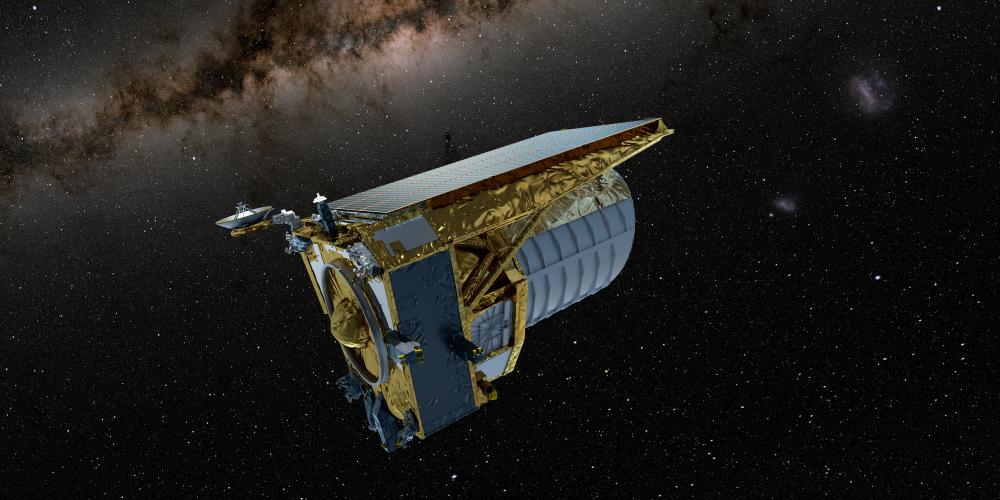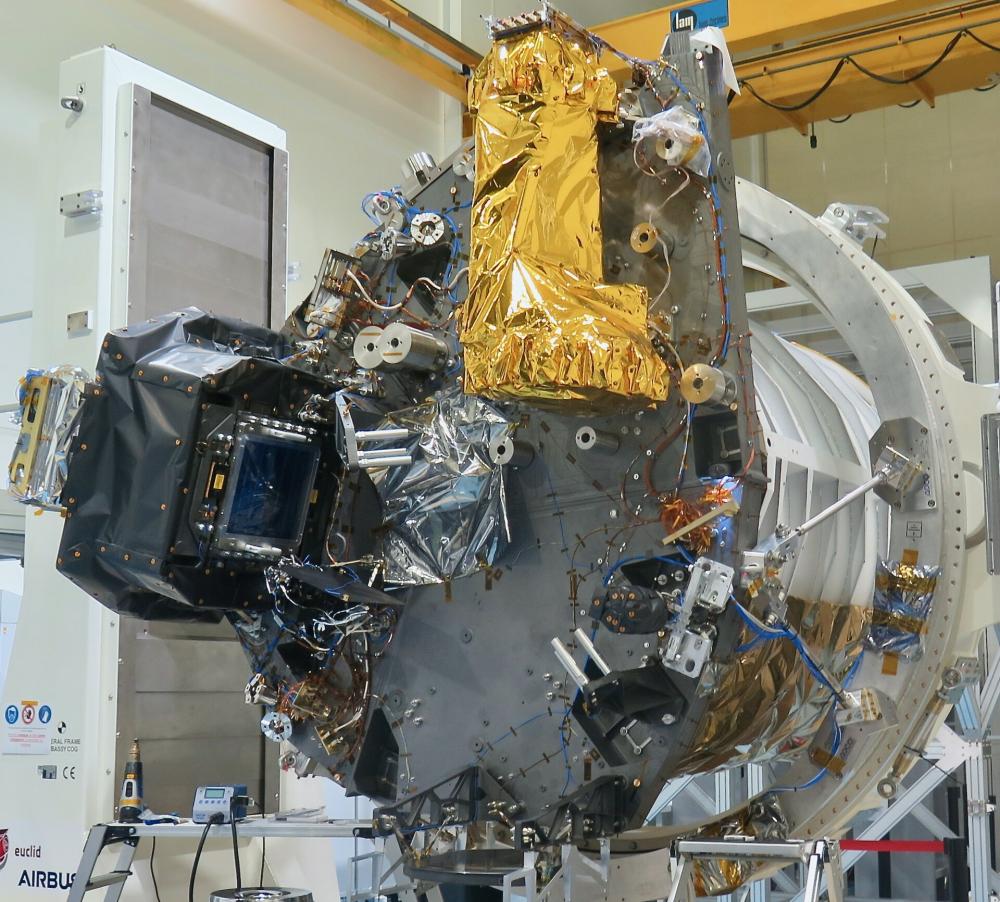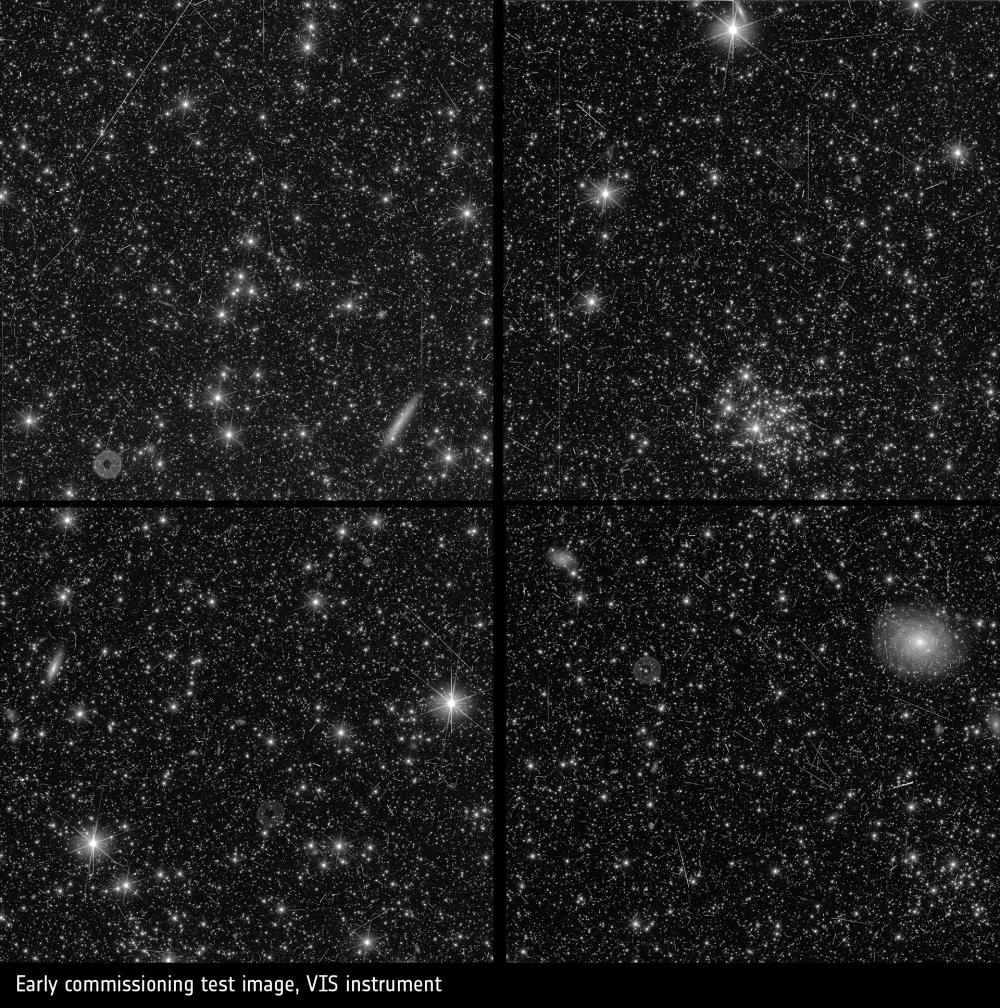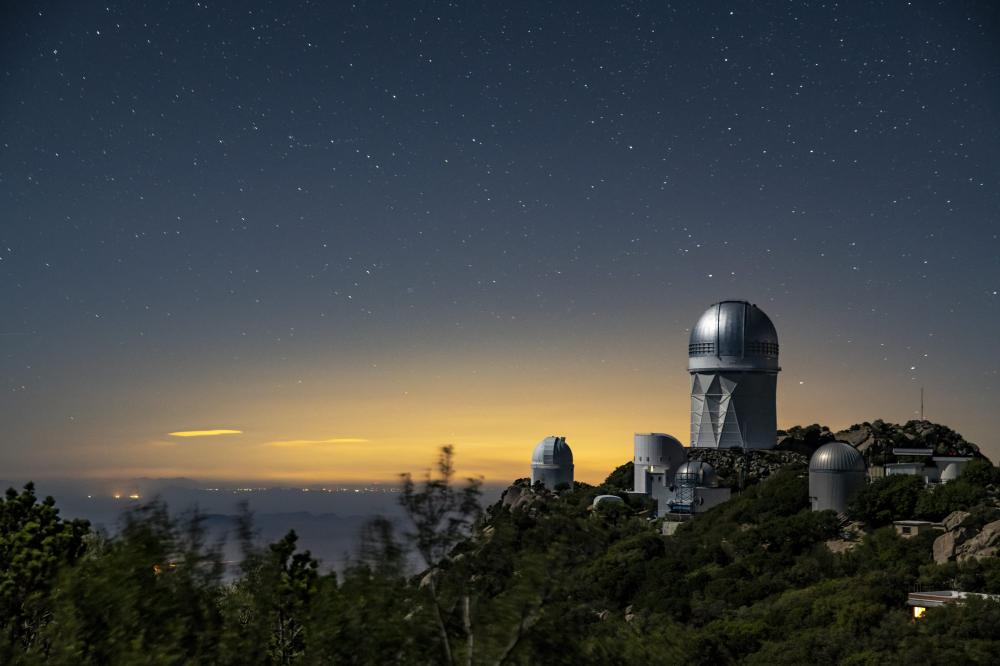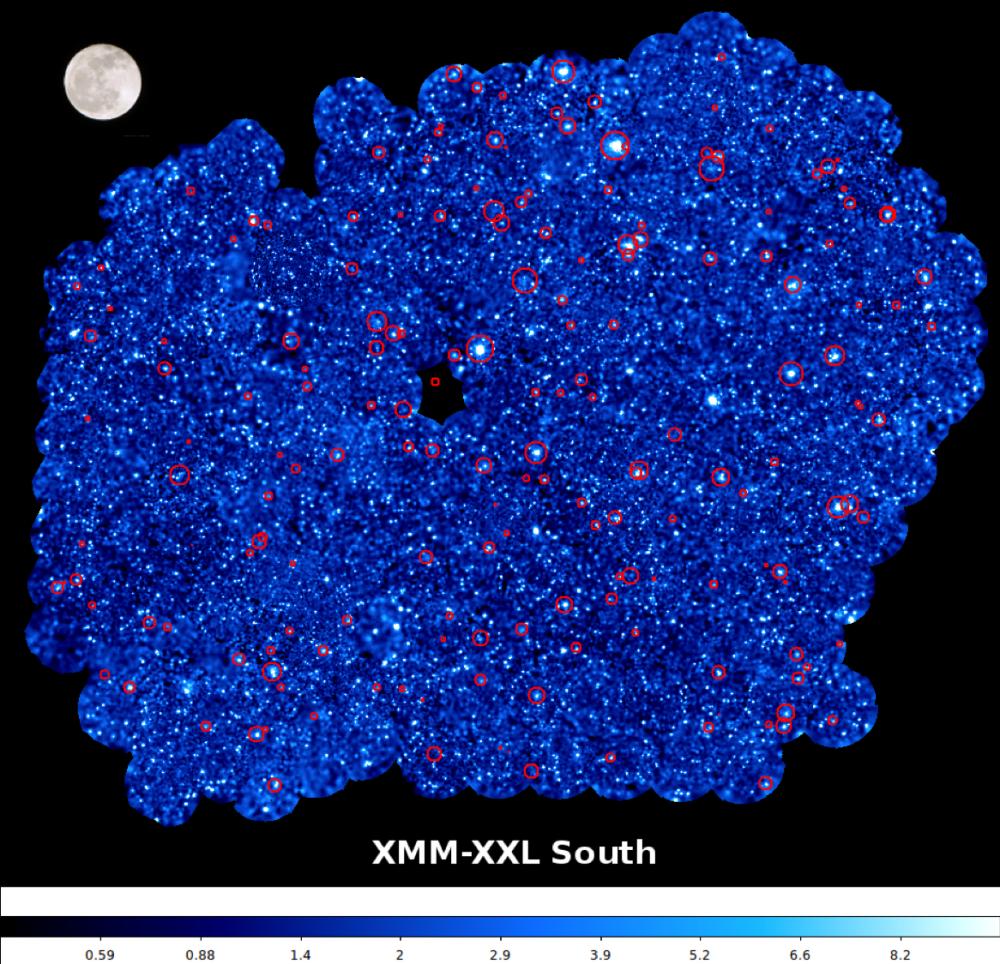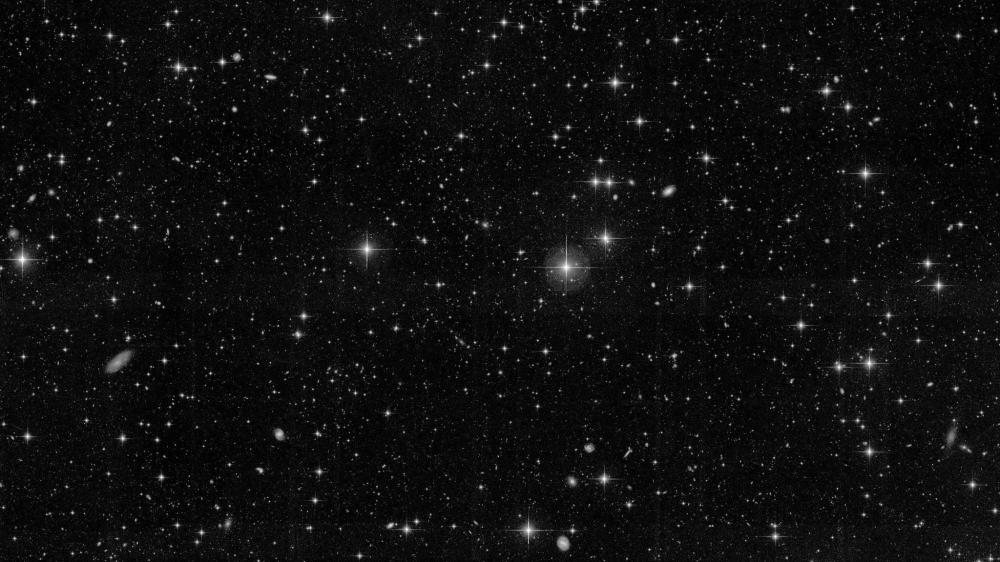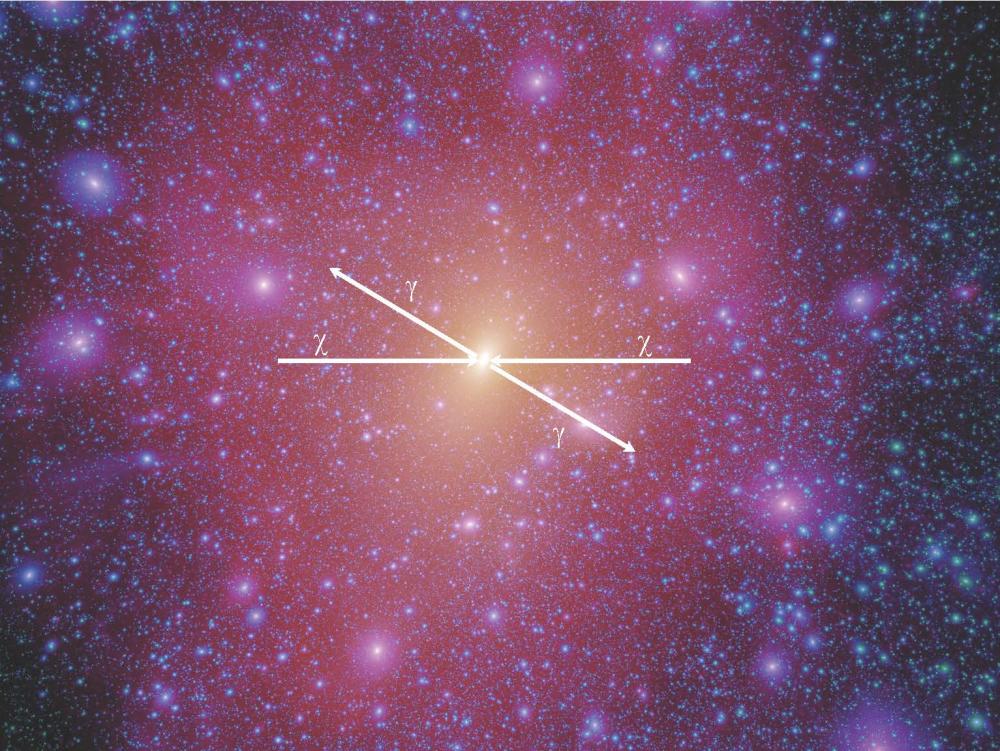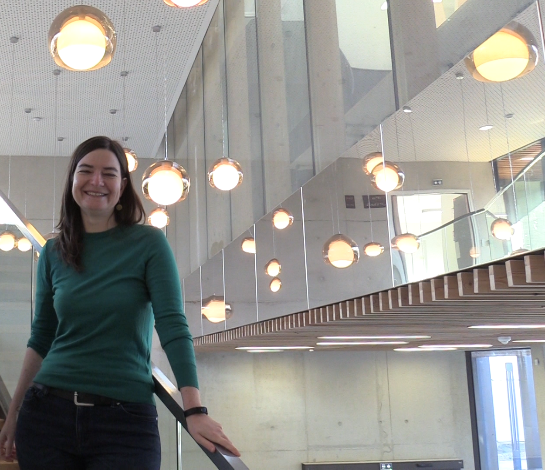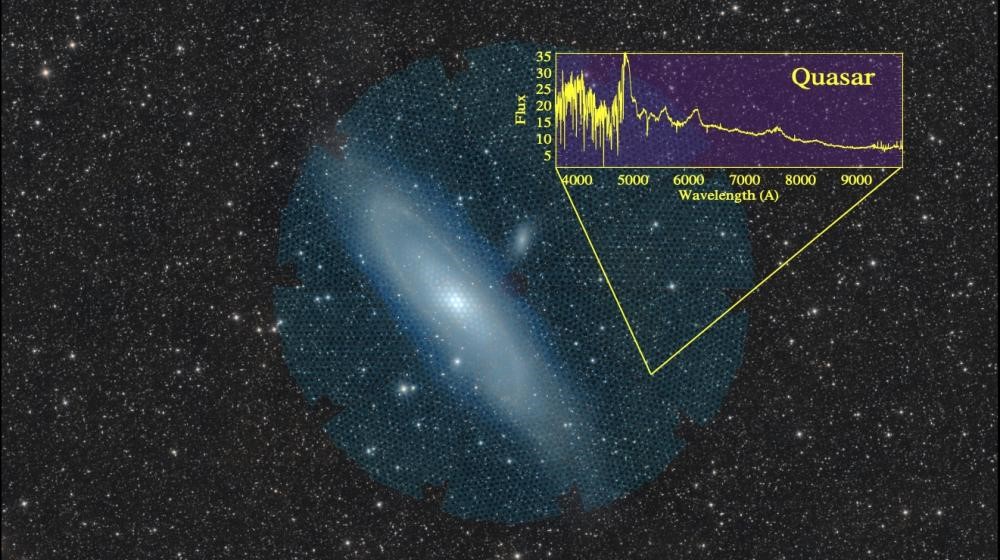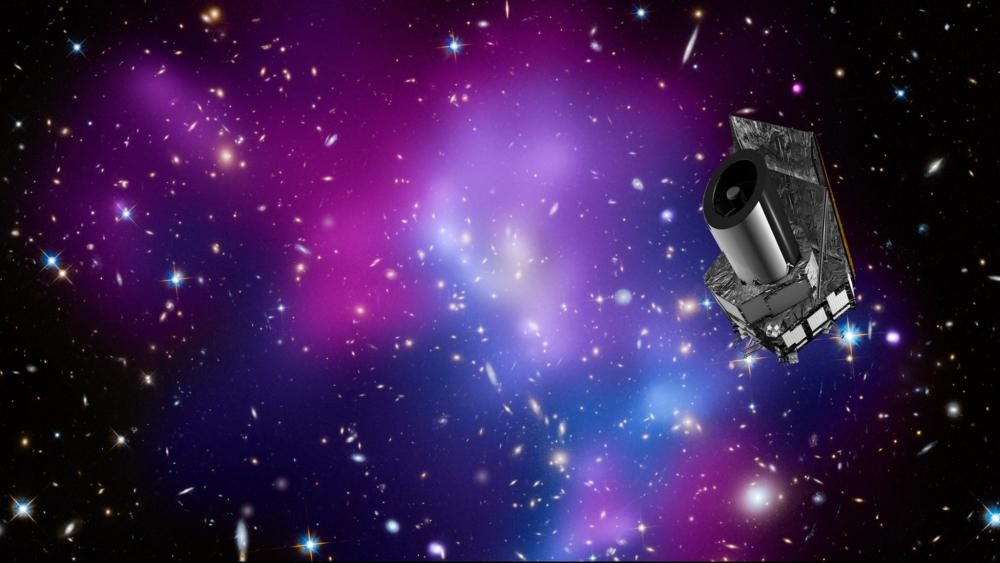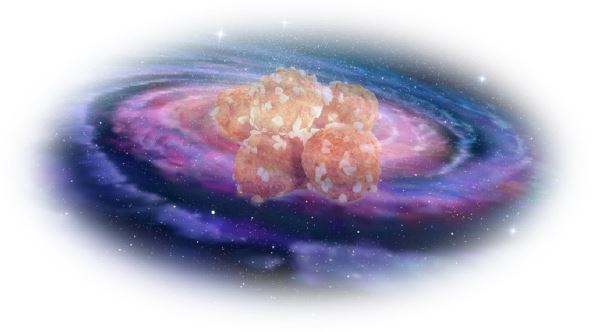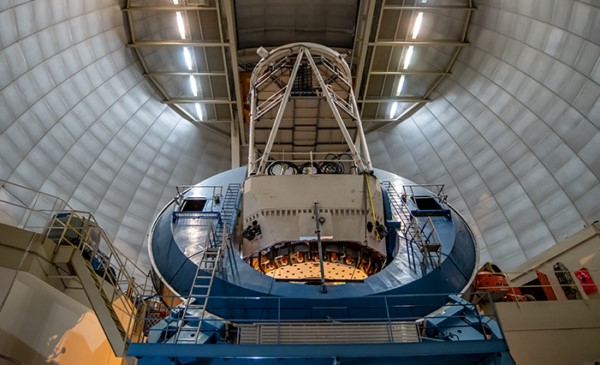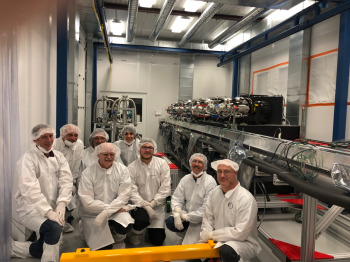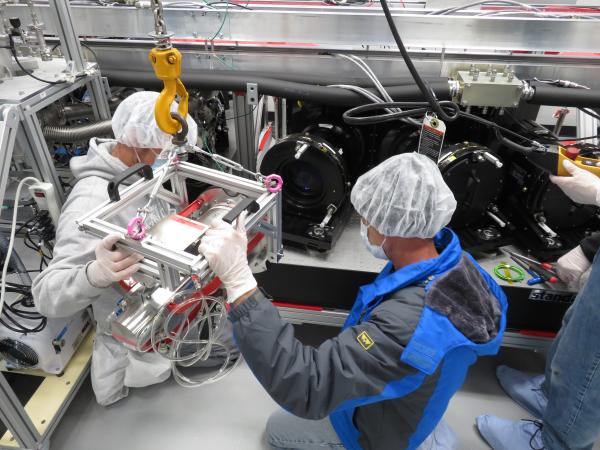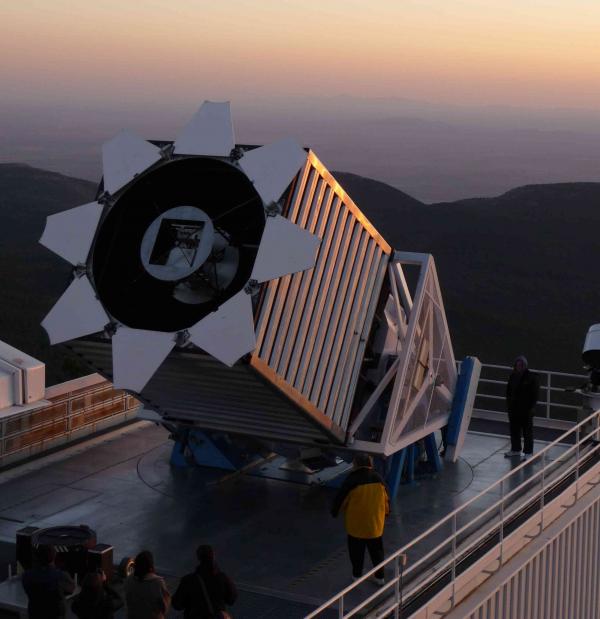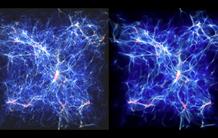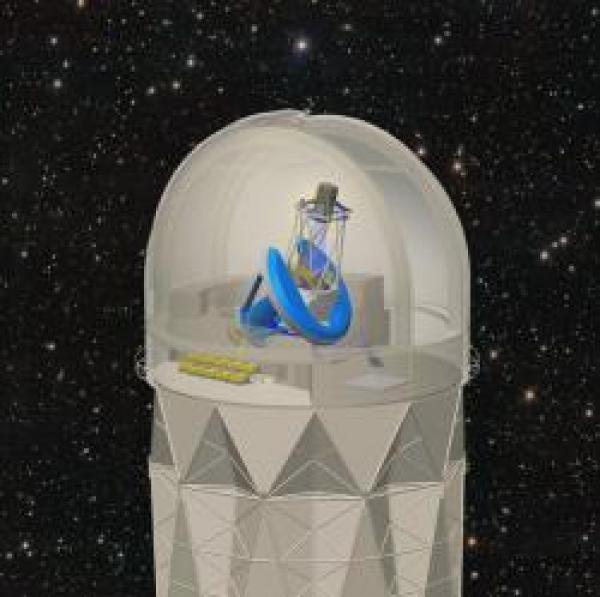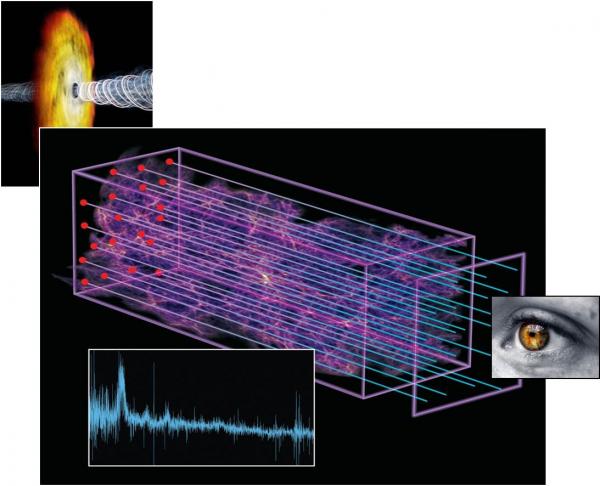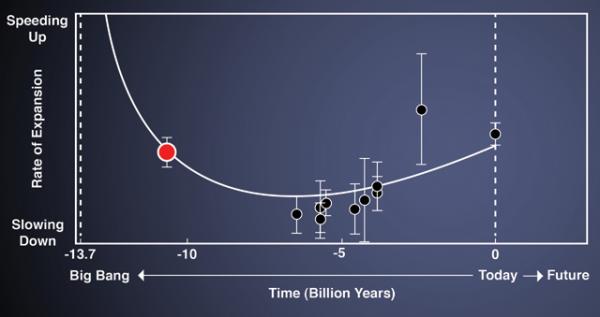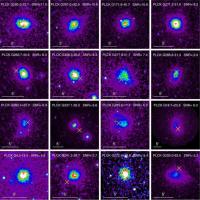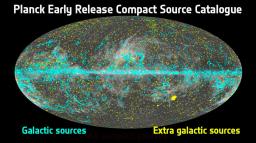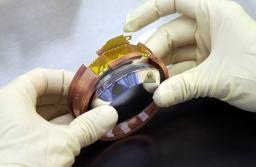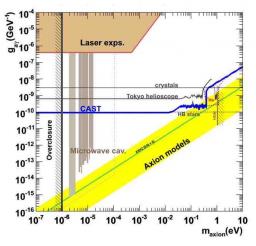On 15 October, ESA's Euclid space mission revealed the first piece of its grand map of the Universe, showing millions of stars and galaxies. This first piece of Euclid's survey was revealed at the International Astronautical Congress in Milan by ESA Director General Josef Aschbacher and Director of Science Carole Mundell.
Thanks to an agreement between CEA and ESA, two experts in image processing, Jean-Charles Cuillandre and Emmanuel Bertin, both astronomers at the Observatoire des Sciences de l'Univers de Paris-Saclay (OSUPS) and members of CEA Irfu's Astrophysics Department, produced this mosaic under ESA supervision. The project's IT logistics were handled by the OSUPS Data and Operations Centre (IDOC), with technical support from the VirtualData platform at the Paris-Saclay mesocentre.
The Euclid collaboration today publishes five reference papers on the mission and ten scientific papers based on the first images unveiled to the public in November 2023, as well as the new images presented today by ESA.
This phase of preliminary observations conducted last fall provides a glimpse into the telescope's exceptional performance. The first scientific papers already reveal the discovery of newly formed rogue planets, the richness of the globular cluster population around nearby galaxies, the discovery of new low-surface-brightness dwarf galaxies in a neighboring galaxy cluster, the distribution of dark matter and intra-cluster light in galaxy clusters, and dozens of massive galaxies dating back to a time when the Universe was only 5% of its current age.
In parallel with these 15 articles, ESA today unveils five new images based on these observations, once again showcasing the sharpness of Euclid's images and its ability to observe all scales of the Universe from the optical to the near-infrared domain over a wide field of view, more than twice the surface area of the full Moon.
The CEA plays a major role in the entire mission within the Euclid collaboration, from design and implementation to its scientific exploitation over the next six years. The CEA is also heavily involved in this scientific validation program for the telescope set up by ESA. Jean-Charles Cuillandre, an astronomer at the CEA-Irfu Department of Astrophysics, analyzed these first scientific data transmitted by Euclid to create color images and enable their scientific exploitation. He is a co-author of the 10 scientific papers detailing the initial discoveries, including 2 as the first author, one on the Perseus galaxy cluster and the other on image processing.
UPDATE [03/26/2024]: Euclid's optics de-icing procedure has produced much better results than expected. The main suspect in the blurred vision of Euclid's VIS instrument was the coldest mirror behind the telescope's main optics. After warming it by just 34 degrees, from -147°C to -113°C, was enough for all the icy water to evaporate. Almost immediately, Euclid regained its sight with 15% more light from the Universe! Scientists and engineers were thus able to determine precisely where the ice had formed, and where it was likely to form again. Find out more on the ESA page.
A few layers of water ice - with the width of a DNA strand - are beginning to affect Euclid's vision; a common issue for spacecraft in the freezing cold of space, but a potential problem for this highly sensitive mission that requires remarkable precision to study the nature of the dark Universe. After months of research, Euclid's teams across Europe, including CEA-Saclay, have devised a new procedure designed to defrost the mission's optics, which involves independently heating the mirrors. The campaign unfolded as planned, and while it's still too early to definitively establish its effectiveness, preliminary analyses are promising.
To reveal the influence of the dark components of the Universe, over the next six years Euclid will be observing the shapes, distances and movements of billions of galaxies. This mapping will cover periods going back to the last 10 billion years of cosmic history, in order to gain a better understanding of where, when and how dark energy and matter - two key components of the universe that are still a mystery - act.
As a prelude to the mission, it was decided to illustrate the satellite's scientific and instrumental capabilities through a series of images of the nearby Universe. Jean-Charles Cuillandre, an astronomer in CEA/IRFU's astrophysics department, led this 'ERO' (Early Release Observations) campaign over several months, with a group of scientists from the Euclid collaboration and ESA, from the choice of the five astrophysical sources to image processing, from raw data to analysed images, combining the responses of the VIS (visible light) and NISP (near infrared) instruments.
The Euclid satellite, launched from Cape Canaveral on July 1st, is traveling to reach its orbit at the second Lagrange point, which it should reach in early August. This transit time has been used to commission Euclid, checking the satellite's services such as communications, power, and pointing, and then the two instruments, VIS and NISP, as well as fine-tuning the telescope's focus. The instrument teams have just released the first "raw" images (untreated) to mark the success of instrument commissioning.
Marc Sauvage (astrophysicist at DAp/Irfu and one of the two French representatives on the Euclid consortium council): "These images perfectly match what we had simulated, but in a simulation, we know that everything we see was deliberately placed there, so in a way, it's not surprising. Here, everything we see is real, and nothing we see was known at this level of detail; it makes us want to look into every corner, to enlarge everything to see as much detail as possible. And since there is a tremendous amount of detail in just these two images, it becomes dizzying!"
Michel Berthé (Euclid project leader at DAp/Irfu): "I am truly amazed by the beauty of these images and the amount of information that can be found in them. We are only at the very beginning of the analysis of these initial results, but they are already very promising.
All the teams at CEA who have worked for more than 10 years on the design, production, and testing of the elements we have provided for the VIS and NISP instruments are particularly proud of these initial results, which demonstrate the nominal operation of our supplies as well as the entire satellite."
The Universe is immensely big, and getting bigger all the time. To study dark energy, the mysterious force behind the accelerating expansion of our Universe, scientists are using the large Dark Energy Spectroscopic Instrument (DESI) survey to map over 40 million galaxies, quasars and stars. Today, the collaboration has released its first batch of data, with nearly 2 million astrophysical objects for researchers to study. It is also publishing 15 papers on the scientific study of these data, and on the instrument, operations and validation of the survey observation strategy.
The data set (80 terabytes) comes from 2,480 exposures taken over six months during the so-called "survey validation" phase in 2020 and 2021 and processed in Python language on the supercomputer at the National Energy Research Scientific Computing Center (NERSC, Berkeley, USA). During this period, between the instrument's commissioning and the start of the official scientific campaign, researchers ensured that the instrument's performance would meet their scientific objectives - for example, by checking the time needed to observe galaxies of different luminosities, and validating the selection of astrophysical objects such as galaxies, quasars and stars to be observed.
Read the Berkeley press release : https://newscenter.lbl.gov/2023/06/13/desi-early-data-release-holds-nearly-two-million-objects/
For the first time since the XMM launch (1999), a cosmological analysis constraining the density of matter in the universe, from a catalog of 178 galaxy clusters detected by XMM, has been possible and in an autonomous way, i.e. with its own distance measurements and without calling upon additional information from numerical simulations or other cluster samples. This analysis was conducted in the framework of the XXL consortium, mainly by Christian Garrel during his thesis at the Astrophysics Department (DAP) of CEA Paris-Saclay (see the article on arXiv).. The results confirm the standard cosmological model in a completely independent way, with an accuracy rivalling with other probes covering much larger portions of the sky. The existing "cosmological" tension between the cosmological analyses of the clusters and the CMB PLANCK is thus lifted; there is no longer any need to use massive neutrinos.
This cosmological analysis from clusters has been possible thanks to the new method ASpiX, developed at DAP allowing to model properly the distant clusters. In the distant Universe, we only detect massive clusters, thus blue, which appear red because of the expansion of the Universe. Mathematically, the software analyses all possible combinations of the effect of cosmology on the properties of clusters.
The cosmological analysis exploiting all the observations of the XXL program is in progress and will include about 300 clusters. The novelty is that it will combine the ASpiX method with artificial intelligence techniques that allow identifying very quickly the cosmological model that best reflects the observed properties of the cluster population.
Scientists from the CosmoStat laboratory at CEA have produced within the international science collaboration UNIONS (Ultraviolet Near Infrared Optical Northern Survey) a reference catalogue of 100 million gravitationally lensed distant galaxies, one of the largest datasets ever created. This new collection is based on thousands of deep images of the northern sky captured by MegaCam, a large digital camera built at CEA, mounted on the Canada-France-Hawaii Telescope (CFHT). Three new publications present dark-matter mass maps of the cosmic web, showing how the high-density regions in these maps help measure the still poorly known properties of dark matter. In the near future these observations will provide essential support to the European space telescope Euclid. This ESA satellite mission will map the cosmic web over the entire accessible sky at an unprecedented resolution to measure the properties of the mysterious dark energy.
Space-based experiments such as the Fermi satellite's Large Area (LAT), which detects gamma rays above 100 MeV, reveal a population of sources with no astrophysical counterpart at other wavelengths. Some of these have the characteristics required to be "dark matter subhalo" candidates predicted by cosmological simulations to populate the Milky Way halo. The range of dark matter candidates with masses below a few hundred GeV are already excluded by Fermi observations. To test the higher masses, higher energy range observations are needed and the H.E.S.S. ground-based Cherenkov telescope array is the ideal instrument. Thus, a team of physicists from Irfu and laboratories in Heildelberg and Tübingen conducted a thorough selection of some of the most promising objects to be observed by H.E.S.S. to elucidate their possible identification as 'dark matter subhaloes' at TeV. The H.E.S.S. results exclude this interpretation for dark matter particles in the TeV range. This work was published in the Astrophysical Journal in July 2021 (arxiv link).
Valeria Pettorino was awarded with the 2020 MCAA (Marie Curie Alumni Award) for her outstanding career (CEA/IRFU, Saclay) for her work in the Euclid collaboration and her involvement in the scientific community through various activities such as mentoring, event organisation, communication and more recently science diplomacy. This award is presented by the MCAA association, which is an international network of all researchers who have received a Marie Curie Fellowship.
See : Valeria Pettorino talks about dark energy: from theory to data
After a particularly successful first campaign of tests and measurements, the Dark Energy Spectroscopic Instrument (DESI) has just successfully started its 5-year observing program. The international collaboration, under the lead of Berkeley Lab, has the ambitious goal to carry out the largest survey of galaxies and quasars. It will be used to draw the most accurate 3D map of the Universe and to elucidate the mystery of "dark energy".
A large, five-year survey to map the Universe and unravel the mysteries of "dark energy" officially began on May 15, 2021 at the Kitt Peak National Observatory near Tucson, Arizona. To carry out its mission, the Dark Energy Spectroscopic Instrument (DESI) will capture and study light from tens of millions of galaxies and other distant objects in the Universe.
Nearly 200 researchers were involved in collecting, processing and assembling images of half the sky to prepare for the start of observations by DESI, the Dark Energy Spectroscopic Instrument, which aims to solve the mystery of dark energy.
In order for DESI to begin its 5-year mission (2021-2026) to produce the largest 3D sky map ever made, researchers first needed a gigantic 2D map of the Universe. Based on 200,000 images from 1405 nights of observations on three telescopes and several years of satellite data, this 2D map is the largest ever produced, based on the area of sky covered, the depth of the imagery and the more than one billion images of galaxies it contains.
The Sloan Digital Sky Survey (SDSS) published in July a complete analysis of the largest three-dimensional map of the Universe ever created, reconstructing the history of its expansion over a period of 11 billion years.
To measure cosmological parameters, the Euclid space telescope will use two main probes: gravitational lensing (Weak Gravitational Lensing) and galaxy distribution (Galaxy Clustering). These measurements will allow us to study dark energy and dark matter, which affect the growth of cosmic structures and the accelerated expansion of the Universe.
In addition to its implications on instrumental developments and data processing, Irfu is actively involved in the development of algorithms needed to prepare the extraction of cosmological parameters that will be derived from Euclid measurements.
Coordinated by Valeria Pettorino, physicist at Irfu's CosmoStat laboratory, in collaboration with Tom Kitching (UCL[1]) and Ariel Sanchez (MPE[2]), an international team from the Euclid collaboration with complementary expertise in theory and observation has just completed a 3-year study characterizing the performances expected from Euclid for these observational probes.
Publication an Arxiv: https://arxiv.org/pdf/1910.09273.pdf
[1] University College London ; [2] Max Planck Institute for extraterrestrial physics
The missing mass of the universe or non-baryonic dark matter is probably made up of particles that remain to be discovered. Massive and neutral, with very weak interactions, they still escape a detection that would identify them. While conventional photons are massless, dark matter could be made up of particles of a new type, similar to massive photons. New experimental results on the search for non-baryonic matter in this form, obtained by a team of three Irfu members, have just been published in Physical Review Letters[1].
‘First light’ for the Dark Energy Spectroscopic Instrument (DESI): as the installation phase nears completion, this new instrument is due to undergo final tests before starting to create a giant map of the sky in early 2020, a mission that is scheduled to run for five years. CEA, the French National Centre for Scientific Research (CNRS), Aix-Marseille University and French company Winlight System have played a significant role in the project to develop this international instrument which aims to scan the sky in an attempt to understand the effects of dark energy.
The installation of DESI, the Dark Energy Spectroscopic Instrument at the Kitt Peak Observatory in Arizona, has just passed an important milestone: with 6 operational spectrographs on site, the minimum configuration required to meet the scientific objectives of the project has been reached. At the end, DESI will have 10 spectrographs and will commit itself from 2020 to the spectroscopic survey of 35 million galaxies and quasars, to study the dark component of the Universe. Irfu, responsible for the cryogenic part of the spectrographs, has made a major contribution to the success of this installation and is currently finalizing the qualification of the cameras of the last spectrograph in Saclay. In parallel, other essential milestones for the construction of the instrument are achieved.
The Dark Energy Spectroscopic Instrument (DESI) is intended to make the spectroscopic survey of 35 million galaxies and quasars from 2020 onwards, to study precisely the properties of dark energy. Its installation, started in 2018, has recently entered a new phase with the reception and assembly of the first two spectrographs out of the 10 that the instrument will include. Irfu, partner of the project since the beginning and responsible for the cryogenic part of the spectrographs, has successfully completed this installation. The next 8 spectrographs will be installed next May and September under the coordination of the Irfu team, in partnership with the local teams.
vidéo réalisée par Victor Silva (Irfu/DIS)
More than twenty years after the discovery of the acceleration of the expansion of the Universe, the nature of the physical phenomenon at the origin of this acceleration, called "dark energy", is still unknown. The current model of cosmology is based on general relativity as a theory of gravitation and establishes a theoretical prediction for the quantity of galaxies that form at a given period of the Universe. This cosmological parameter is called the growth rate of cosmic structures. It allows to test directly the gravitation theory at the scale of these large structures.
For the first time, the eBOSS multi-spectrograph mounted on the Sloan Digital Sky Survey telescope in New Mexico, allowed to measure this parameter from the distribution of spatial correlations of quasars. Quasars are among the brightest sources of light in the Universe and allow us to probe an era almost unexplored by this cosmological test, when the Universe was between 3 and 7 billion years old. The sample on which the analysis is based corresponds to 2 years of data collection and has already allowed the selection of more than 148,000 quasars. The measurements made confirm the validity of the model of cosmology based on general relativity and can also be used to constrain alternative theories of gravity.
The results were published in the Monthly Notices of the Royal Astronomical Society (P. Zarrouk et al, 2018).
The collaboration continues to acquire data with final analysis planned for the end of 2019, which will double the sample size. DPhP cosmologists are heavily involved in all stages of the eBOSS program, as well as in its successor, the DESI project located at the Kitt Peak National Observatory in Arizona, which is scheduled to begin data collection in 2020.
Several decades after its discovery, dark matter remains enigmatic. Researchers from IRFU have tested three models of dark matter in which the formation of large structures was modeled using supercomputing. The reconstruction of large structures from observations of quasar spectra favors the hypothesis of a standard "cold" dark matter and sets some of the strongest constraints on these invisible masses.
An international team from the Sloan Digital Sky Survey (SDSS) has carried out the first large-scale spectroscopic analysis of quasars, and was able to create a full 3D map of the universe and its large structures as it was 6 billion years ago. For now, the standard model of Cosmology, based upon Einstein's general theory of relativity, is confirmed.
The Dark Energy Spectroscopic Instrument (Desi) will analyze the light emitted by 35 million galaxies and quasars at various times in the past of the Universe and up to 11 billion years to better understand dark energy. Its move into the construction phase in 2016 crowns several years of research and development that have resulted in a solid design and a credible observation strategy. Irfu, a partner in the project from the outset, has played a key role. A look back at a year that saw the project become a reality.
A new phase begins for DESI
Astronomers at the Sloan Digital Sky Survey (SDSS) used 140,000 distant quasars to measure the rate of expansion of the Universe when it was only a quarter of its present age. This is the best measure of the rate of expansion at any time in the 13 billion years since the Big Bang. Researchers from Irfu (CEA) and CNRS played a major role in this discovery.
The Baryon Oscillation Spectroscopic Survey (BOSS), the main component of the third generation of SDSS surveys, was the first to use gigantic quasar transmitters to map the distribution of intergalactic hydrogen gas and thus measure the structure of the young Universe. The selection of the objects to be observed is carried out by researchers from the Research Institute on the Fundamental Laws of the Universe (CEA) and the final BOSS quasar catalog is produced by researchers from the Astroparticle and Cosmology Laboratory (CNRS/CEA/University Paris Diderot/Observatoire de Paris/CNES) and the Paris Astrophysics Institute (CNRS/Université Pierre et Marie Curie).
Three years ago, BOSS used 14,000 quasars to produce the largest 3D maps of the Universe.
Two years ago, with 48,000 quasars, it detected baryonic acoustic oscillations in these maps, which are evidence of the inhomogeneities of the primordial universe. Today, with more than 140,000 quasars, he has obtained extremely precise measurements of the size of these structures, which were presented at the April 2014 meeting of the American Physical Society in Savannah, Georgia.
Astrophysicists from the SDSS-III (Sloan Digital Sky Survey) project, composed largely of French researchers, CEA Irfu, CNRS In2p3 and INSU, have made the first measurement of the rate of expansion of the young Universe, only three billion years old out of the 13.7 billion, when gravity was still slowing down its expansion, before its current phase of expansion accelerated by the Dark Energy. They used a new technique to map the distant Universe in three dimensions. This result is online at arXiv.org.
Different phases of the expansion of the Universe
Hubble and Lemaître highlighted the expansion of the Universe in the 1920s by making two types of measurements for the same set of galaxies: the distance between these galaxies and us, and the speed of these galaxies (using the Doppler effect on the lines of their spectra).
Their observations are at the origin of the current "standard" model of cosmology. For most of the history of the Universe, this expansion has continued to slow down under the effect of matter gravitation and radiation. But since five billion years ago, when the Universe was about 7 billion years old, this behavior has been reversed: the expansion started to accelerate, probably due to a mysterious repulsive force produced by what has been called: "dark energy". Experiments in cosmology have made it possible to observe this period of recent acceleration, but not the primitive deceleration of the Universe. To be able to measure this deceleration requires to go back to the first billions of years of its history, to go far back in time, therefore to observe far in space. For this, galaxies are no longer enough: at such great distances, their luminosity becomes too low.
An international team, including scientists from the Astrophysics Department-AIM and the Particle Physics Department of CEA-Irfu, has just used the Planck satellite to discover galaxy clusters with characteristics that were previously unknown. These clusters, which contain up to a thousand galaxies, are the largest structures in the Universe. Many of them are located very far away from us, and we still know relatively little about them. Astrophysicists were able to detect the new clusters thanks to the imprint left in the background radiation of the universe by the hot gas from the clusters. Of the 189 clusters detected by Planck at distances from 1 to 5 billion light-years, 20 were previously unknown. Thanks to a joint program with the XMMNewton x-ray satellite, some of these new clusters could be observed, revealing weaker luminosity and a highly perturbed gas distribution. These must therefore be clusters with different characteristics.
These results were presented at a scientific colloquium on results from the Planck satellite, held from 10th to 14th January 2011 in Paris. They were published in a special issue of Astronomy & Astrophysics.
For a more detailed account, see also the French version.
The scientific community had to wait 18 months for the data collected by Planck, the European Space Agency satellite. Now, the first scientific results are in. The first edition of the compact sources catalog (ERCSC, Early Release Compact Sources Catalogue), with several thousand sources detected by Planck, has been published and presented in the context of an international colloquium, held from 11th to 14th January 2011 at the Cité des Sciences et de l'Industrie in La Villette (Paris).
Read the joint press release from CNES, CNRS, CEA, and ESA
Also refer to the program of the colloquium
|
Contact:
|
The new generation of detectors from the Edelweiss experiment, which is searching for dark matter, have just delivered their first results. Remarkably reliable and robust, they have proved excellent at removing interference signals. Although only just installed and not yet perfected, these new detectors have improved the experiment's sensitivity by a factor of 10 in terms of its capacity to measure an interaction with a "wimp"1 , a weakly interacting massive particle, which is one of the candidates for dark matter.
Article submitted to Phys Lett. B (online)
In 2010 the usable mass of detectors will be tripled in order to improve their discovery potential still further.
This jump in sensitivity puts this experiment in amongst the leading group of experiments worldwide that are seeking to detect these new particles. These first results have just been submitted for publication in the journal Physics Letters B
The Nobel Prize for Physics 2008 rewarded Makoto Kobayashi and Toshihide Maskawa for having realised that the weak interaction does not affect particles and antiparticles in the same way1. In this theory, it was expected that the strong interaction would exhibit the same type of asymmetry between quarks and antiquarks.
However the asymmetry is not there! A problem! To explain this anomaly of the strong interaction, theoreticians have postulated the existence of a new particle known as the "axion", named after a detergent because it will help to clean up the problem. Expected to be both neutral and light, this particle will be analogous to a photon, with which it could be coupled. On the other hand it will only interact slightly with matter, so slightly that, to date, it has never been observed.
CAST2 is an experiment designed to detect this hypothetical particle which may be produced abundantly by the sun. The collaboration recently published their results ("Journal of Cosmology and Astroparticle Physics") which have enabled the limits of the predicted mass of the axion to be reduced.
The search for axions continues, thanks to improvement in the performance of the CAST Micromegas detectors, enabling the level of noise to be reduced to an extremely low level, in the low energy regime between 1 and 10 keV, and so to further reduce the lower limit for detection of these hypothetical particles.
Why are we interested in axions?
Axions are particles which were introduced by theoreticians to explain the apparent symmetry between matter and antimatter in the strong interaction. These axions, neutral and of very low mass, are also candidates to make up the dark matter in our universe. Theoretical models and astrophysical observations limit the mass of the axion to being in the range between several µeV/c2 and several eV/c2.
The absence of observation of axions in the CAST experiment has enabled an experimental upper limit to be established for the axion-photon coupling constant, for masses less than 0.4 eV/c2 (figure 1). For the first time this limit has reached the yellow band favoured by the theoretical models.


